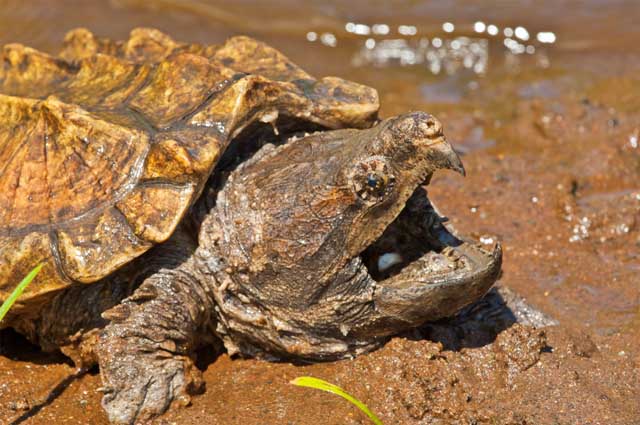Two New Snapping Turtle Species Named
Posted by: Adam Davies on May 5th, 2014
A great story about how there are still new creatures to be discovered.
The alligator snapping turtle, the biggest freshwater turtle in North America, is actually three species, according to a study that appeared April 9 in the journal Zootaxa.
The prehistoric reptile is already known for its size—it weighs up to 200 pounds (90 kilograms)—and longevity of nearly a century.

The alligator snapping turtle (M. temminckii above) is actually three species. Photograph by Michelle Gilders, Alamy
Loosely related to common snapping turtles, alligator snappers have a dinosaur-like appearance and a range that’s limited to rivers in the southeastern United States that drain into the Gulf of Mexico (map).
Scientists made the discovery using a multipronged approach, examining wild turtles’ genes and body shapes as well as those of fossilized turtles. (See video: “Fishing with Alligator Snappers.”)
Thanks to their work, the original species (Macrochelys temminckii) has been joined by two newly classified species—M. suwannensis and M. apalachicolae, which are named after the river systems they populate: the Suwannee River and Apalachicola River.
And Then There Were Three
Study leader Travis Thomas, of the Florida Fish and Wildlife Conservation Commission, and team caught turtles in rivers throughout the Gulf Coast region and collected blood samples from their tails to compare their DNA, which revealed significant differences.
The team also measured the reptiles’ skulls and carapaces, or shells, and found significant variations among them. For instance, snappers found in the Suwannee River have a particularly distinctive caudal notch, a scooplike structure at the back of the shell.
The DNA and physical evidence, combined with analysis of fossil snappers dating back to 16 million years ago, confirmed the turtles are separate species. (Also see “Mating Turtles Fossilized in the Act.”)
“These turtles depend on rivers and only leave the water to lay eggs, so it’s not surprising that there are genetic differences between drainages,” study co-author Joe Roman, a biologist at the University of Vermont in Burlington, said by email.
But “we were surprised that the breaks have lasted for hundreds of thousands, perhaps millions, of years—enough for them to evolve into distinct species.”
The team estimates that the more distinctive-looking Suwannee River snappers diverged from the others roughly 9.6 million years ago, and that the western alligator snapping turtle (M. temminickii) and Apalachicola River snapper last shared a common ancestor about 5.9 million years ago before their genetic lineages diverged.
“Now we know alligator snappers in the Suwannee River are a unique species found nowhere else in the world,” Collette Adkins Giese, a biologist with the Center for Biological Diversity who wasn’t involved in the research, said in a statement.
Read the rest of the story here.
About Adam Davies
I am an explorer, adventurer, and a cryptozoologist. I've traveled to some of the most remote and dangerous parts of the world in search yet-to-be-discovered animal species. From the dense jungles of the Congo and Sumatra, to the deserts of Mongolia, and the mountains of Nepal, I have traveled the world in search of scientific evidence of the existence of these creatures.








